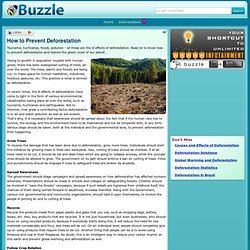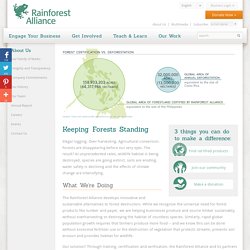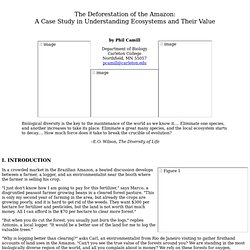

Amazon Rainforest: deforestation. Amazon Rainforest: deforestation.

Video. Britannica Online for Kids. How to Prevent Deforestation. Owing to growth in population coupled with human greed, there has been widespread cutting of trees, all over the world.

The trees, plants and forests are being cut, to make space for human habitation, industries, livestock pastures, etc. This practice is what is termed as deforestation. In recent times, the ill effects of deforestation have come to light in the form of various environmental catastrophes taking place all over the world, such as tsunamis, hurricanes and earthquakes. Not to mention, how great a contributing factor deforestation is to air and water pollution as well as soil erosion. That's why, it is necessary that awareness should be spread about the fact that if the human race has to survive, the ecology and the environment have to be maintained and not be tempered with, in any form.
Grow Trees To reverse the damage that has been done due to deforestation, grow more trees. Follow Crop Rotation Farmers should make use of environment savvy techniques like crop rotation. Keeping Forests Standing. Illegal logging.

Over-harvesting. Agricultural conversion. Forests are disappearing before our very eyes. The result? At unprecedented rates, wildlife habitat is being destroyed, species are going extinct, soils are eroding, water safety is declining and the effects of climate change are intensifying. What We’re Doing The Rainforest Alliance develops innovative and sustainable alternatives to forest destruction.
Our solution? Evaluating Our Impact To make sure that we are as effective as possible, we routinely conduct and evaluate impact studies on our work and continually adjust our approach. Help us keep forests standing » Learn About How We Are Also... The Deforestation of the Amazon: A Case Study in Understanding Ecosystems and Their Value - Case Study Collection - National Center for Case Study Teaching in Science.
The Deforestation of the Amazon: A Case Study in Understanding Ecosystems and Their Value Biological diversity is the key to the maintenance of the world as we know it....

Eliminate one species, and another increases to take its place. Eliminate a great many species, and the local ecosystem starts to decay.... How much force does it take to break the crucible of evolution? --E.O. In a crowded market in the Brazilian Amazon, a heated discussion develops between a farmer, a logger, and an environmentalist near the booth where the farmer is selling his crop. "I just don't know how I am going to pay for this fertilizer," says Marco, a disgruntled peasant farmer growing beans in a cleared forest pasture. "But when you do cut the forest, you usually just burn the logs," replies Antonio, a local logger. "Why is logging better than clearing? " "Try feeding five children with spiritual benefits, Carl" Marco snaps. "I agree with you, Marco," adds Antonio. 'Boom and bust' of deforestation.
The Amazon forest may be worth more alive than dead, researchers say Cutting down Amazon forest for cattle and soy does not bring long-term economic progress, researchers say.

A study of 286 Amazon municipalities found that deforestation brought quick benefits that were soon reversed. Writing in the journal Science, the researchers say the deforestation cycle helps neither people nor nature. They suggest that mechanisms to reward people in poorer countries for conserving rainforest could change this "lose-lose-lose" situation. Pros and Cons of Deforestation. Study: Economic Boost of Deforestation Is Short-Lived. For the people who live in the Brazilian rain forest, the perfectly logical thing to do is cut it down.

Large swaths of the rain forest are burned or chopped down each year (4,621 square miles in 2008) because that land is worth more to its human denizens deforested — for the value of the timber and the cleared farmland — than it is intact. The ecological fallout is, of course, immense. The Amazonian rain forest is perhaps the most densely populated place on Earth — inhabited by a vast variety of plants and animals that we have not yet begun to map — and it is also the largest terrestrial carbon sink on the planet, absorbing 2 billion metric tons of carbon dioxide in a normal year.
The argument for deforestation has always been that the economic benefits to local communities are too great to overlook. But now a new study in the current issue of Science suggests that's not true. It's not hard to see why deforestation pays off, at least initially. But those improvements are transitory. Deforestation. Return to the Environmental Issues Index Deforestation Topic Rainforest Destruction What Causes It For a while, we actually saw a slow down in rainforest destruction for timber and farming as people became aware of the great diversity of life in this habitat.

How Does It Affect Us Rainforests are very productive habitats. What Has Been Done to Fix It In 1994, at the Earth Summit (United Nations Conference on the Environment and Development) in Rio de Janeiro, Brazil countries from all over the world agreed to try to protect at least 12% of their wild habitats.
What Can You Do to Help Americans kids eat a lot of fast food, even though it's expensive and full of fat and calories. Instead of buying a cut Christmas tree, try having a live tree this year. High Resolution PDF with Post Assessment click here. Pros & Cons of Deforestation. In: Energy/Environment. 3 so far.

Add one? News: Rain Forest. For centuries, humans have relied on rain forests for a variety of products.

Foods such as tomatoes, peppers, corn, rice, coconuts, bananas, coffee, cocoa, tapioca, beans, and sweet potatoes all originally came from the rain forest. Many civilizations have exploited the timber in rain forests and cleared the land for farms. Some preliterate tribes have actually lived in the rain forests for thousands of years. Today people rely on tropical rain forests for a variety of everyday products: paper (7 percent of all paper pulp comes from the rain forest); rubber (used in tires and other products); wax (used in plastics); mahogany and teak (used in wood products such as furniture); and many other items. Destructive Activities.